
A gin and tonic is a highball cocktail made with gin and tonic water poured over a large amount of ice. The ratio of gin to tonic varies according to taste, strength of the gin, other drink mixers being added, etc., with most recipes calling for a ratio between 1:1 and 1:3. It is usually garnished with a slice or wedge of lime. To preserve effervescence, the tonic can be poured down a bar spoon. The ice cools the gin, dulling the effect of the alcohol in the mouth and making the drink more pleasant and refreshing to taste.

A Manhattan is a cocktail made with whiskey, sweet vermouth, and bitters. While rye is the traditional whiskey of choice, other commonly used whiskies include Canadian whisky, bourbon, blended whiskey, and Tennessee whiskey. The cocktail is usually stirred with ice then strained into a chilled cocktail glass and garnished traditionally with a maraschino cherry. A Manhattan may also be served on the rocks in a lowball glass.
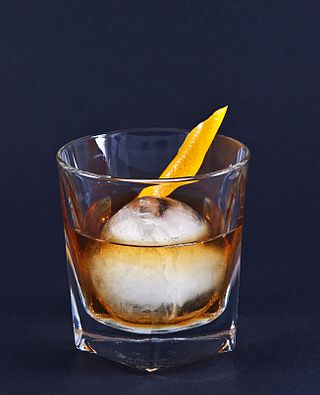
The old fashioned is a cocktail made by muddling sugar with bitters and water, adding whiskey, and garnishing with an orange slice or zest and a cocktail cherry. It is traditionally served with ice in an old fashioned glass.

The Zombie is a Tiki cocktail made of fruit juices, liqueurs, and various rums. It first appeared in late 1934, invented by Donn Beach at his Hollywood Don the Beachcomber restaurant. It was popularized on the East coast soon afterwards at the 1939 New York World's Fair.

A bitters is traditionally an alcoholic preparation flavored with botanical matter for a bitter or bittersweet flavor. Originally, numerous longstanding brands of bitters were developed as patent medicines, but now are sold as digestifs, sometimes with herbal properties, and as cocktail flavorings.

The martini is a cocktail made with gin and vermouth, and garnished with an olive or a lemon twist. Over the years, the martini has become one of the best-known mixed alcoholic beverages. A popular variation, the vodka martini, uses vodka instead of gin for the cocktail's base spirit.

The Singapore sling is a gin-based sling cocktail from Singapore. This long drink was developed sometime before 1915 by Ngiam Tong Boon, a bartender at the Long Bar in Raffles Hotel, Singapore. It was initially called the gin sling.
Pink gin was historically used to reference a type of cocktail made fashionable in England in the mid-19th century, consisting of Plymouth gin and a dash of Angostura bitters, a dark red bitters that makes the whole drink pinkish. In recent years, the term Pink gin has also been used to define a specific category of gin where a range of fruits and flavourings are infused into the gin to give it a pink color.
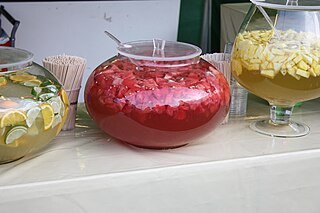
The term punch refers to a wide assortment of drinks, both non-alcoholic and alcoholic, generally containing fruits or fruit juice. The drink was introduced from the Indian subcontinent to England by employees of the East India Company in the late 17th century. Punch is usually served at parties in large, wide bowls, known as punch bowls.

The negroni is a cocktail, made of equal parts gin, vermouth rosso, and Campari, generally served on the rocks, and commonly garnished with an orange slice or orange peel. It is considered an apéritif.
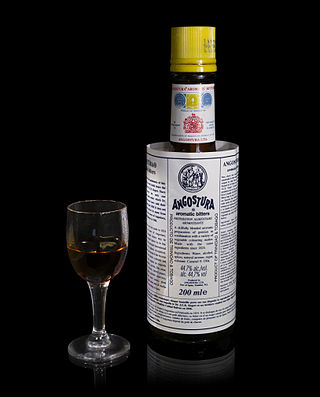
Angostura bitters is a concentrated bitters based on gentian, herbs, and spices, produced by House of Angostura in Trinidad and Tobago. It is typically used for flavouring beverages, or less often, food. The bitters were first produced in the town of Angostura, hence the name, but do not contain angostura bark. The bottle is recognisable by its distinctive oversized label. Angostura is Spanish for "narrowing", the town of Angostura having been at the first narrowing of the Orinoco River.

The Fine Art of Mixing Drinks is a book about cocktails by David A. Embury, first published in 1948. The book is noteworthy for its witty, highly opinionated and conversational tone, as well as its categorization of cocktails into two main types: aromatic and sour; its categorization of ingredients into three categories: the base, modifying agents, and special flavorings and coloring agents; and its 1:2:8 ratio for sour type cocktails.
A gunner is a cocktail served in clubs, bars, golf clubs, especially those popular with expats, in Singapore, Hong Kong and other parts of the Far East and India formerly under British colonial rule. It consists of equal parts ginger beer and ginger ale with a dash of Angostura bitters and sometimes a measure of lime cordial or lemon juice. It is regarded as a non-alcoholic drink, although Angostura bitters is 44.7% alcohol by volume. It is noted for its refreshing qualities, especially in warm weather.

The Carousel Piano Bar & Lounge is the only revolving bar in New Orleans, Louisiana. The bar is inside the Hotel Monteleone and overlooks Royal Street in the French Quarter of New Orleans. Installed in 1949, the 25-seat circular bar turns on 2,000 large steel rollers, powered by a 1⁄4 hp (190 W) motor. The bar rotates at a rate of one revolution every 15 minutes. In addition to the rotating bar, an adjoining room includes booths and tables with live entertainment offered nightly.
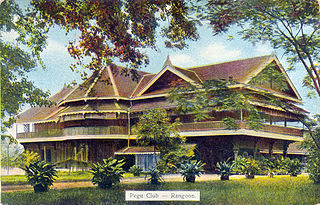
Pegu Club is a recognized heritage site in Yangon, Myanmar, which was a Victorian-style Gentlemen's club founded in 1871 during the British colonization of Burma. The building was built in 1880 and finished in 1882. Pegu Club used to be a place for British officials to spend their time for a drink or two. It was well known because of its signature Pegu Club Cocktail. In southeast Asia, Pegu Club was an equivalent place to the Royal Selangor Club of Kuala Lumpur and The Tanglin Club of Singapore. Rudyard Kipling, as a young newspaperman, visited Pegu Club when he was in Yangon in 1889. Paul Theroux visited Pegu Club in the early 1970s and wrote about it in his book The Great Railway Bazaar. The first phase of the Pegu Club's restoration was completed in 2018.

The Malecon is a cocktail named after the El Malecón, the winding beachfront avenue atop the seawall in Havana, Cuba.
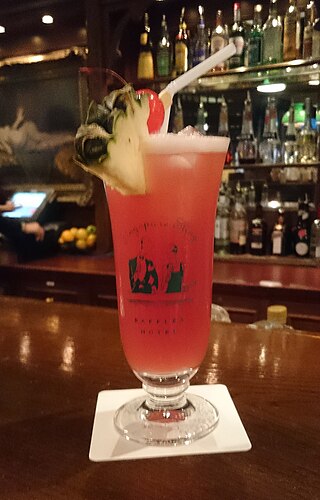
A sling is a drink historically made with sugar, hot or cold water, nutmeg, and a spirit such as gin, whiskey, rum, or brandy. In its modern form, it is made with gin and, varyingly, of ingredients such as sweet vermouth, lemon juice, simple syrup, Angostura bitters, and soda water. The word sling comes from the German schlingen, meaning "to swallow fast".

The Martinez is a classic cocktail that is widely regarded as the direct precursor to the Martini. It serves as the basis for many modern cocktails, and several different versions of the original exist. These are generally distinguished by the accompaniment of either Maraschino or Curacao, as well as differences in gin or bitters.
A Green Swizzle is an alcohol-containing cocktail of the sour family. It was popular in Trinidad at the beginning of the 20th century but got lost during the course of the Second World War. Today's recipes usually constitute an often distinct divergence from the original.















